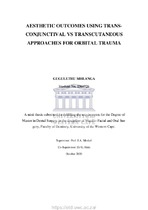| dc.description.abstract | Introduction: Maxillofacial and oral surgeons often encounter challenges when choos-ing an appropriate surgical access for patients who sustained periorbital and orbital trauma. There are various surgical approaches/incisions (transcutaneous and transcon-junctival) used to access the periorbital skeletal framework. However, there is no consen-sus in the literature regarding the aesthetical outcome of these approaches/incisions. Complications of the lower lid such as entropion, ectropion, retraction of lower lid, scar-ring, oedema of lid, canthal mal-position and chemosis are associated with these ap-proaches. Surgeons are posed with these challenges and aim for best aesthetic outcomes and low post-operative complications. Aim: The aim of this study was to compare aesthetic outcome of the transcutaneous ap-proach (subtarsal) to that of the transconjunctival approach when managing orbital trauma. Objectives: The objectives were to compare the aesthetic outcomes between the trans-conjunctival and transcutaneous (subtarsal) approach; to assess unwanted clinical out-comes, such as scaring, lid malposition (ectropion, entropion, scleral show), lid oedema, chemosis, haematoma, ecchymosis, wound dehiscence, infection and canthal malposition for the two approaches. Methodology: Twenty-two patients were enrolled in this study, 11 of which underwent “transconjunctival incision”, and 11 underwent "subtarsal incision". A high quality dig-ital photograph of each patient’s face was taken at specified time periods up to nine months after surgery. Ten Maxillofacial and Plastic surgeons were instructed to rank or-der the 22 photographs applying Q-sort scaling. Results: Eleven patients underwent the transconjunctival (retroseptal) incision. Ten of which had pure blowout fractures and one had a zygomatic complex fracture. Of the 11, seven were black Africans, two were Caucasians and two mixed race. There were four males and seven females in the transconjunctival incision group. The remainder of the 22 underwent the transcutaneous (subtarsal) incision. Six of the 11 were black Africans and five mixed race. There were nine males and two females in the tranconjunctival group. In this group, two patients had pure blowout fractures and nine had zygomatic complex fractures. Scars were visible in the subtarsal group after six months in seven out of the 11 cases (63.6%), but all the scars were rated as mild on the modified Vancouver Scar Scale. Scle-ral show was noted after six months in four of the 11 cases with the subtarsal approach and in two of the 11 cases with the transconjunctival approach. Only one case of ectropion was seen with both approaches and only one case of entropion was noted in the transcon-junctival group. According to the findings of the study, both approaches were found to have good aesthetic outcomes. Results from the expert rating showed a high-quality rank of 96.8% for the transconjunctival incision versus 90.5% for the subtarsal incision. Conclusion: Both approaches demonstrated good aesthetic results. The transconjunctival incision was associated with scleral show and entropion, while the subtarsal incision was more associated with scar formation. However, when performed meticulously, both inci-sions can provide aesthetically pleasing results. | en_US |

